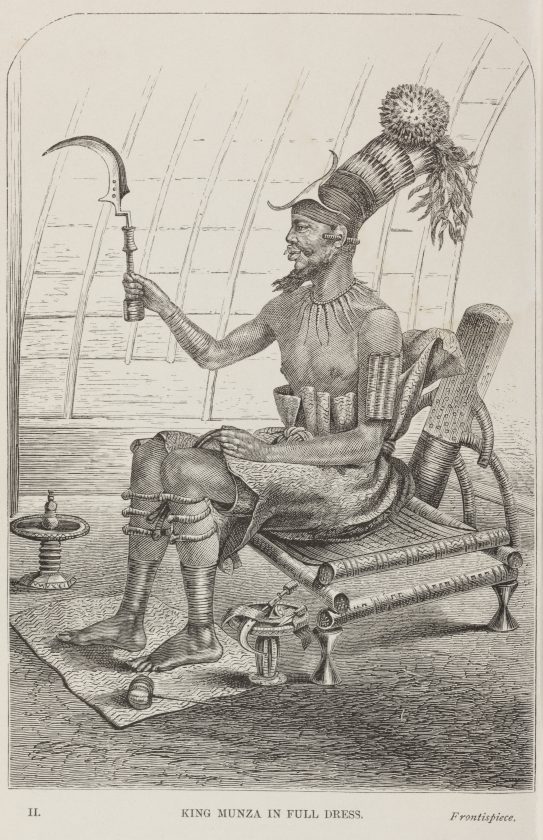‘Striking Iron’ and ‘I Am …’ at African Art Museum
By • July 11, 2019 0 1045

It cannot be easy to build an interpretive framework for African art in America, to honor material that has such a vexed relationship with its keepers. With a limited budget and less name recognition than many of its fellow Smithsonian museums, the National Museum of African Art has been refining and strengthening its approach, regularly offering concentrated displays of pre- and post-colonial artifacts and complementing them with powerful and diverse surveys of the contemporary African art scene.
Two exhibitions now on view offer a case study in the museum’s targeted but multivariant presentation of African history, culture and artistic achievement.
“Striking Iron: The Art of African Blacksmiths” focuses on the artistry of blacksmiths in Africa south of the Sahara, featuring works dating from the 17th century to recent times. In the gallery above, “I Am … Contemporary Women Artists of Africa” features modern and contemporary artistic practice, putting forward an inclusive vision of women making art in relation to the compelling issues that define their times.
A simple but effective harmony resonates among these two shows. It should not be a controversial statement that blacksmithing all but oozes masculinity. The forging and tooling of molten iron is a brawny and rugged trade, historically dangerous and physically grueling. Instead of complementing “Striking Iron” with an exhibition of traditional African women’s craft like beadwork, a woman-focused exhibition that deals with the contemporary art landscape offers a more ambitious historical arc in conjunction with male-female roles in the African art economy.
The story of “I Am …” begins — in some ways — in 2012, when the National Museum of African Art launched the Women’s Initiative Fund to increase the profile of Africa’s women in the arts through exhibitions, publications, acquisitions and strategic global partnerships. This exhibition is one result, as is the overall increasing representation of women artists in the museum’s permanent collection.
Crossing both generational and cultural divides, “I Am …” explores the vital contributions of women to numerous issues including the environment, identity, politics, race, sexuality, social activism and faith. It features some of the more beautiful and intentional works I have seen on the issue of contemporary female identity, migration and lineal exchange.
Among the show’s highlights are works by Billie Zangewa and Njideka Akunyili Crosby. “Constant Gardener,” a 2014 piece by Zangewa, born in 1973 in Malawi, is a textile work that portrays a defiant but personal scene in her life from after her son was born, when she would rise at night to plant the fresh produce that would later nourish her child. Both sewing and motherhood are matters of identity; Zangewa, who works in South Africa, uses them together to great poetic effect.
In “Wedding Souvenirs” of 2016, Crosby responds to the paintings of Goya, the history of portraiture and such personal effects as souvenirs from her wedding and that of her brother in an intimate self-portrait. She describes her mixed-media paintings as creating a space where cultures come together to create something new, which she achieves by juxtaposing visual cues from Nigeria, where she was born in 1983; Spain; Los Angeles, where she now works; and elsewhere to recognize the hybrid experience of people who move, travel and share experiences across borders.
The timeline of “Striking Iron” stretches far into the past, beginning roughly 2,500 years ago, when technologies of iron smelting and forging were first developed on the African continent. The ability to create with iron is often understood as a divine gift, and those who effect its transformation are revered — and also feared — for their awesome capabilities. With extraordinary innovation and sophistication, African smiths have transformed iron ore, one of earth’s most basic natural resources, into objects of utility, empowerment, prestige, ritual potency and artistic expressiveness, enhancing the values and meanings of community life.
For centuries, tools made from iron have helped Africans forage, hunt and till the soil, making prosperity possible through efficient and effective management of household and agricultural chores. Knives, hoes, plows, sickles, machetes, axes and adzes have long been among the blacksmith’s most prolific creations. In particular, short- and long-handled hoes for cultivating and sickles for harvesting have enabled African peoples to survive and thrive.
Essential to labor, family and community life, iron tools have also been rendered into objects of social and economic status with sacred meanings and ritual efficacies. Iron currency tokens are among the most compelling and virtuosic of sub-Saharan blacksmiths’ designs. The shapes of precolonial currency tokens were often derived from blade forms of tools and weapons; so essential was the work accomplished by forged iron objects to local political economies that they were synonymous with value itself.
These currency forms stood as payment in the exchanges that mattered most in life: marriage, litigation, ransom of battle captives and the purchase of horses, enslaved persons and other prized commodities. Hoe-blade-shaped currencies were created as bridewealth tokens by many African societies, linking agricultural productivity to the reproductive power and labor a wife brings to a household. Currencies used as bridewealth constituted material praise of the woman, recognizing her as an individual with life-sustaining capacities.
It is a testament to the museum that these shows weave together as effectively as they stand apart, threading a needle through centuries of disparate cultural traditions that span a continent nearly double the size of North America. Today, an African woman does not need to look for approval or value outside of herself. And many communicate through their art and craft practices. But the act of symbolizing and celebrating their value is part of a tradition that goes back countless generations.
National Museum of African Art
950 Independence Ave. SW
10 a.m. to 5:30 p.m. daily
Free admission
“Striking Iron” closes Oct. 20
“I Am …” closes July 5, 2020
africa.si.edu
202-633-4600

